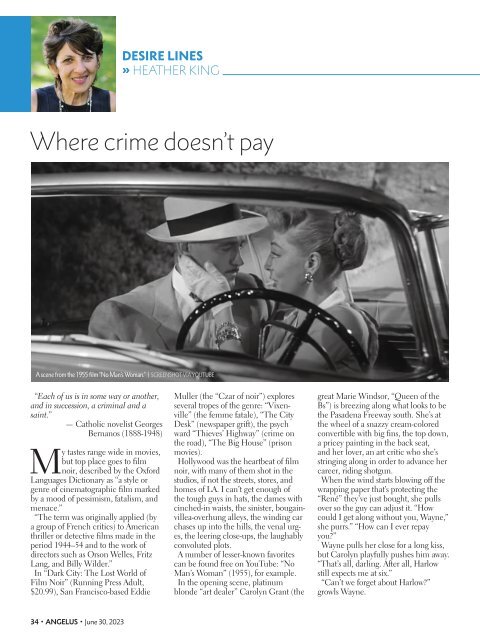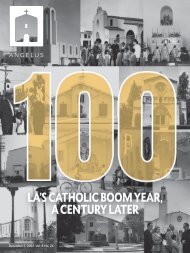Angelus News | June 30, 2023 | Vol. 8 No 13
On the cover: Everywhere you turn, it seems as if everyone is focusing on artificial intelligence — how it can be used, how it should be used, or if it should be used at all. Starting on Page 12, Elise Italiano Ureneck speaks with two Catholics experienced in artificial intelligence on how it could impact everything from education, well-being, and human demise.
On the cover: Everywhere you turn, it seems as if everyone is focusing on artificial intelligence — how it can be used, how it should be used, or if it should be used at all. Starting on Page 12, Elise Italiano Ureneck speaks with two Catholics experienced in artificial intelligence on how it could impact everything from education, well-being, and human demise.
You also want an ePaper? Increase the reach of your titles
YUMPU automatically turns print PDFs into web optimized ePapers that Google loves.
DESIRE LINES<br />
HEATHER KING<br />
Where crime doesn’t pay<br />
A scene from the 1955 film “<strong>No</strong> Man’s Woman.” | SCREENSHOT VIA YOUTUBE<br />
“Each of us is in some way or another,<br />
and in succession, a criminal and a<br />
saint.”<br />
— Catholic novelist Georges<br />
Bernanos (1888-1948)<br />
My tastes range wide in movies,<br />
but top place goes to film<br />
noir, described by the Oxford<br />
Languages Dictionary as “a style or<br />
genre of cinematographic film marked<br />
by a mood of pessimism, fatalism, and<br />
menace.”<br />
“The term was originally applied (by<br />
a group of French critics) to American<br />
thriller or detective films made in the<br />
period 1944–54 and to the work of<br />
directors such as Orson Welles, Fritz<br />
Lang, and Billy Wilder.”<br />
In “Dark City: The Lost World of<br />
Film <strong>No</strong>ir” (Running Press Adult,<br />
$20.99), San Francisco-based Eddie<br />
Muller (the “Czar of noir”) explores<br />
several tropes of the genre: “Vixenville”<br />
(the femme fatale), “The City<br />
Desk” (newspaper grift), the psych<br />
ward “Thieves’ Highway” (crime on<br />
the road), “The Big House” (prison<br />
movies).<br />
Hollywood was the heartbeat of film<br />
noir, with many of them shot in the<br />
studios, if not the streets, stores, and<br />
homes of LA. I can’t get enough of<br />
the tough guys in hats, the dames with<br />
cinched-in waists, the sinister, bougainvillea-overhung<br />
alleys, the winding car<br />
chases up into the hills, the venal urges,<br />
the leering close-ups, the laughably<br />
convoluted plots.<br />
A number of lesser-known favorites<br />
can be found free on YouTube: “<strong>No</strong><br />
Man’s Woman” (1955), for example.<br />
In the opening scene, platinum<br />
blonde “art dealer” Carolyn Grant (the<br />
great Marie Windsor, “Queen of the<br />
Bs”) is breezing along what looks to be<br />
the Pasadena Freeway south. She’s at<br />
the wheel of a snazzy cream-colored<br />
convertible with big fins, the top down,<br />
a pricey painting in the back seat,<br />
and her lover, an art critic who she’s<br />
stringing along in order to advance her<br />
career, riding shotgun.<br />
When the wind starts blowing off the<br />
wrapping paper that’s protecting the<br />
“René” they’ve just bought, she pulls<br />
over so the guy can adjust it. “How<br />
could I get along without you, Wayne,”<br />
she purrs.” “How can I ever repay<br />
you?”<br />
Wayne pulls her close for a long kiss,<br />
but Carolyn playfully pushes him away.<br />
“That’s all, darling. After all, Harlow<br />
still expects me at six.”<br />
“Can’t we forget about Harlow?”<br />
growls Wayne.<br />
34 • ANGELUS • <strong>June</strong> <strong>30</strong>, <strong>2023</strong>


















